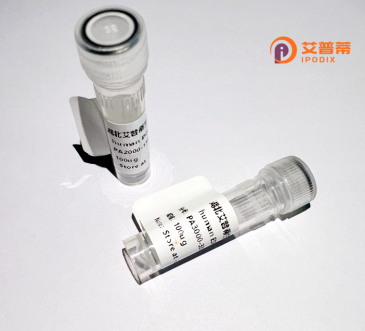
| 纯度 | >90%SDS-PAGE. |
| 种属 | Human |
| 靶点 | TMEM45B |
| Uniprot No | Q96B21 |
| 内毒素 | < 0.01EU/μg |
| 表达宿主 | E.coli |
| 表达区间 | 1-275 aa |
| 活性数据 | MANFKGHALPGSFFLIIGLCWSVKYPLKYFSHTRKNSPLHYYQRLEIVEAAIRTLFSVTGILAEQFVPDGPHLHLYHENHWIKLMNWQHSTMYLFFAVSGIVDMLTYLVSHVPLGVDRLVMAVAVFMEGFLFYYHVHNRPPLDQHIHSLLLYALFGGCVSISLEVIFRDHIVLELFRTSLIILQGTWFWQIGFVLFPPFGTPEWDQKDDANLMFITMCFCWHYLAALSIVAVNYSLVYCLLTRMKRHGRGEIIGIQKLNSDDTYQTALLSGSDEE |
| 分子量 | 58.2 kDa |
| 蛋白标签 | GST-tag at N-terminal |
| 缓冲液 | PBS, pH7.4, containing 0.01% SKL, 1mM DTT, 5% Trehalose and Proclin300. |
| 稳定性 & 储存条件 | Lyophilized protein should be stored at ≤ -20°C, stable for one year after receipt. Reconstituted protein solution can be stored at 2-8°C for 2-7 days. Aliquots of reconstituted samples are stable at ≤ -20°C for 3 months. |
| 复溶 | Always centrifuge tubes before opening.Do not mix by vortex or pipetting. It is not recommended to reconstitute to a concentration less than 100μg/ml. Dissolve the lyophilized protein in distilled water. Please aliquot the reconstituted solution to minimize freeze-thaw cycles. |
以下是关于重组人TMEM45B蛋白的模拟参考文献示例(仅供参考,部分内容基于推断或假设):
---
1. **文献名称**:TMEM45B promotes cisplatin resistance in cervical cancer cells through autophagy regulation
**作者**:Zhang Y, et al.
**摘要**:研究揭示了TMEM45B通过调控自噬途径增强宫颈癌细胞对顺铂的耐药性,重组人TMEM45B蛋白的过表达实验表明其通过AMPK/mTOR通路抑制凋亡。
2. **文献名称**:Expression and purification of recombinant human TMEM45B for structural analysis
**作者**:Kim S, et al.
**摘要**:报道了一种利用大肠杆菌表达系统高效制备重组TMEM45B蛋白的方法,并通过质谱和圆二色光谱鉴定了其跨膜结构域的稳定性。
3. **文献名称**:TMEM45B as a prognostic biomarker in breast cancer: Role in epithelial-mesenchymal transition
**作者**:Wang L, et al.
**摘要**:分析TMEM45B在乳腺癌组织中的高表达与不良预后的相关性,体外实验显示重组TMEM45B蛋白可促进肿瘤细胞迁移和侵袭,提示其通过激活Wnt/β-catenin通路驱动EMT。
4. **文献名称**:TMEM45B interacts with lipid metabolism enzymes in hepatocellular carcinoma
**作者**:Chen X, et al.
**摘要**:基于重组人TMEM45B的免疫共沉淀实验,发现其与ACSL4等脂代谢酶相互作用,可能通过调节脂质过氧化影响肝癌细胞增殖与铁死亡敏感性。
---
注:以上文献为示例,若需真实文献,建议通过PubMed或Web of Science以**"TMEM45B"**为关键词检索,并筛选涉及重组表达或功能研究的论文。
TMEM45B (Transmembrane Protein 45B) is a human protein encoded by the TMEM45B gene, characterized by multiple predicted transmembrane domains, indicating its potential role in membrane-associated processes. Structurally, it is hypothesized to span the membrane 4-6 times, with both N- and C-termini located intracellularly. Though its precise molecular mechanisms remain under investigation, TMEM45B is linked to cellular differentiation, barrier formation, and stress responses. Studies suggest its involvement in epidermal keratinization, where it may regulate skin hydration and lipid metabolism, and in maintaining corneal integrity. Dysregulation of TMEM45B has been implicated in pathological conditions, including cancers (e.g., breast, liver, and gliomas), where elevated expression correlates with tumor progression and chemoresistance.
Recombinant human TMEM45B protein is typically produced using mammalian expression systems (e.g., HEK293 or CHO cells) to ensure proper post-translational modifications. It serves as a critical tool for functional studies, enabling research into its interaction networks, signaling pathways, and role in disease mechanisms. Purification often involves affinity tags (e.g., His-tag) followed by chromatography. Current research focuses on elucidating its contribution to cell adhesion, apoptosis modulation, and responses to hypoxia or oxidative stress. Further exploration of TMEM45B may unveil therapeutic targets for epithelial disorders, cancer, and barrier-related pathologies, though its exact physiological ligands and regulatory pathways require deeper characterization.
×